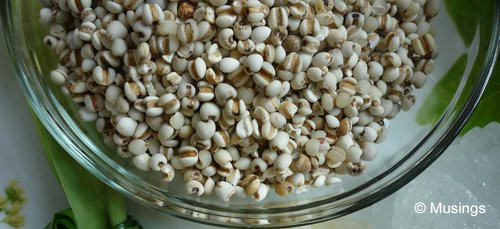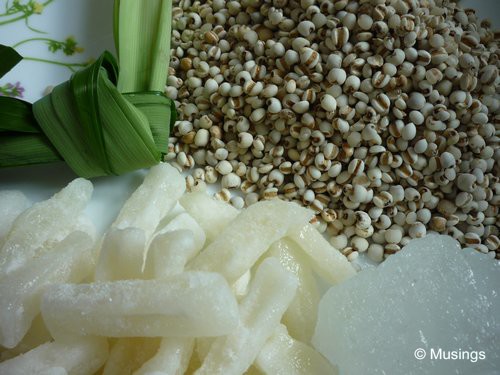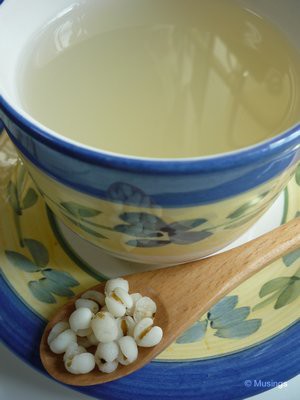Taking barley drink to cool down our bodies on hot days is a common practice amongst the Chinese. There is the barley drink and then there is the China barley drink. One is the true barley and the other is the imitation. Just kidding…! :)

I did some homework on this grain and here is what I’ve gathered. China barley is native to Asia but has been grown worldwide. Although it looks like the big brother of pearl barley (i.e. the true barley), it belongs to a different genus and hence is technically no barley at all. Perhaps due to its production in China, it has been called China barley. Other names for this grain are coix seeds and Job’s tears. In Chinese, it is called 薏仁 (yi ren).
Before I write this post, I don’t have the faintest idea of the benefits (and ‘dangers’) of consuming China barley or that China barley isn’t barley at all. I simply assumed that it was also a cooling grain just like pearl barley. After finding out more on the Internet, I heaved a sigh of relief that China barley is generally beneficial to health. Yes, it has cooling property just like pearl barley. On top of that, it is able to strengthen the spleen, enhance immunity, prevent swelling, remove pus, treat symptoms of diarrhoea and arthritis. Other properties include inducing diuresis and excreting dampness (a TCM term which I have little clue). And I felt good when I read that it could enhance complexion too, hee hee. As for pregnant ladies, do try to avoid China barley as it might interfere with development of foetus.
I was introduced to this grain when my mom started adding it to her home-made cheng teng (清汤). The sweet fragrant taste of China barley left an impression on me then. It is something which pearl barley cannot match up to.
I used to brew pearl barley drink for Yang to help him cool down or ease his cough-induced sore throat. However, I am not fond of pearl barley drink at all. I found the resultant texture too gluey for my liking. I like my cooling drink to have a somewhat clean and refreshing taste. Just a couple of weeks ago, China barley came to mind and I decided to try brewing this type of cooling drink for my family instead. And I was delighted to discover that not just Yang took to the drink positively, Hannah became hooked to it. She has been asking for barley drink ever since. As this is a cooling drink, it should not be consumed in excess and prolonged periods of time.
Okie dok, enuff said. About the recipe, I adapted it from a pearl barley drink recipe from Food4Tots.
Ingredients

- China barley – 200 g
- candied winter melon (冬瓜糖) – 80 g
- rock sugar – 50-60 g (adjust sweetness according to preference)
- pandan leaves – 3, washed and tie into a knot
- water – 2 litres
Method
1) Rinse China barley thoroughly until water runs clear.
2) Soak the China barley grains with 2 litres of tap water for an hour in a big pot which they would be cooked later.
3) Add candied winter melon to the pot and bring water to boil.
3) Once the water starts boiling, skim the scum from the surface. Cover the pot and lower the heat to simmer (gentle bubbling) for about 1 hour.
4) At the last 10 minutes of simmering, add the knot of pandan leaves and rock sugar.
5) Stir to ensure all rock sugar has dissolved. Scoop up 2/3 of cooked barley, some candied winter melon and pandan leaf knot and discard.
6) Serve China barley drink with some of its grains and candied winter melon, warm or chilled.

I usually keep the excess drink in bottles in the refrigerator and warm it up in batches for the next couple of days for consumption. For Hannah, I limit her consumption to 1 cup (~ 190 ml) per day.
Hello Ms Tay,
China barley is v good and I always advice my patients to take them esp when they have water retention (simpler way of putting TCM term dampness).
The ang mo barley removes heat while the China barley removes more dampness and water retention. So its good to remove sluggish-ness and heaviness due to water retention and dampness in body :)
Hope it helps!
Haha, I thought my post might prompt a response from the TCM expert in you :D Thanks a lot on explaining the meaning of dampness! I got a better idea now. :)
Say, what are the causes of dampness / water retention in your patients?
Our weather is damp, and also due to the rich food that we eat. Patients with poor digestion have more problems “excreting” the dampness too. and dampness is known to be v hard to remove: 缠绵难愈. I myself have loads of dampness too, so will feel v sleepy after lunch :S
Sounds like me here :D So, I’m damp!